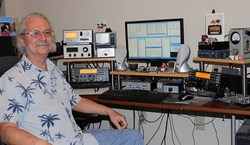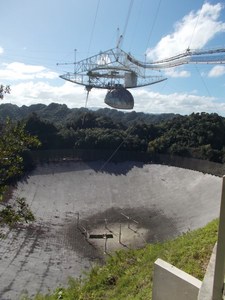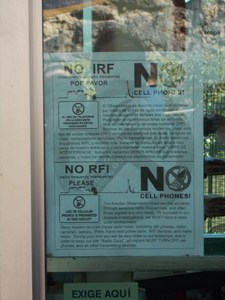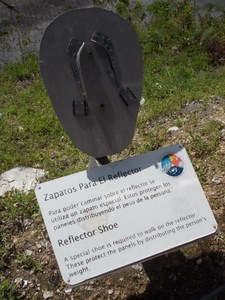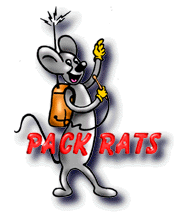 January 15, 2014 Editor: Ward Silver, NØAX | |||||||
IN THIS ISSUE
NEW HF OPERATORS - THINGS TO DO A contest made just for you comes along this weekend - the North American QSO Party's Phone contest. Tim N3QE observes that NAQP is far and away the best place to learn what it is like to CQ. Getting experience on the "other side" of a pileup shows you how to get through when you're search-and-pouncing by good timing, use of crisp phonetics, clean audio, and so forth. BULLETINS If you had trouble submitting your NAQP CW log via the NCJ website (browse function not recognizing the log data or category erroneously reported as QRP) or had team registration difficulties, contest manager Chris KL9A reports that most of the problems have been identified and fixed. If necessary, resubmit your log - the list of logs received is up-to-date - or email your log to Chris at cwnaqpmgr@ncjweb.com. BUSTED QSOS The last issue appears to have been fairly accurate. CONTEST SUMMARY Complete information for all contests follows the Conversation section January 18-19
January 25-26
National Contest Journal Editor, Kirk K4RO reports that the new NCJ website is online with a whole new look and structure. "There is room to expand NCJ contest score and record databases, plus whatever we think of in the future. Contest managers and columnists can now add their own content." If clicking through to the new URL results in a "page not found" error, clear your browser's history cache and try again. Clearing up the old addresses from the Internet's many tubes will take a bit of time. Kirk especially wishes to thank his partner, Susie, for designing the site's fresh look-and-feel, and to K5TR, KM3T, and WA7BNM for contributing to the transfer. Good job, folks! How about that ARRL Centennial QSO Party? Off to a roaring start, it's like a new contest every week! This week's featured states are Nebraska and Delaware, two hard-to-work states at once. Plus, there is W100AW to chase and all of the various stations that count for Centennial Points. If you were active during the national bicentennial in 1976 when we could use special prefixes (I was an ACØ - woo-hoo!), you'll recognize the exuberant atmosphere. Have fun and log 'em all - centennials don't come around very often! The North Coast Contesters (NCC) are proud to announce the 22nd Annual Dayton Contest Dinner with tickets available exclusively via the website hosted by KA9FOX and QTH.com. (No tickets at the door!) To be held on Saturday, May 17th, at the Crowne Plaza hotel in downtown Dayton, John K1AR will MC the festive affair and Doug K1DG will be the featured speaker. 2014 CQ Contest Hall of Fame inductees will be announced and atop the list of many generously-donated prizes, Icom America has donated an IC-7600 transceiver! The annual Contest Dinner is just part of the radiosport revelry that goes on throughout the Dayton Hamvention - don't miss out on the full four nights of the Contest Super Suite! (Thanks, NCC President, Tim K3LR)
WRTC2014 Co-Chair, Randy K5ZD notes "We are exactly six months away from the opening ceremonies! There is a lot of work going on behind the scenes to be ready for the competition." Just take a look at the volunteers at work in the "tower garden"! Randy also notes, "If there is someone worthy that you feel should be nominated for the CQ Contest Hall of Fame, now is the time! The nominating period closes on March 1, 2014. The science of solar study continues at ever-increasing levels of detail. The upcoming NASA-ESA Solar Orbiter mission will carry the largest CMOS imaging detectors for any solar mission to date. Using customized 0.18-μm technology as described in this Electronic Design story, the satellite will carry four imagers of 4 megapixels each for a composite 16-megapixel format. We are sorry to report that Tokyo Hy-Power, a well-known manufacturer of contest-worthy gear, has filed for bankruptcy. Their amplifiers were particularly well-designed and highly regarded. Although support in the U.S. is still being provided through January, there is no word about warranty or other services beyond this month. Fred K1VR reports that the brains behind the Hey, What's That? website are those of Mike KC1QX. Fred also contributes this tip for determining an unambiguous "where's north?" for when you are up on the tower wrestling an antenna. Log on to the site, then "Set your tower height as the height above ground level (instead of the default six feet). "Climb" your tower and look around. Figure out what you should be able to see. Then climb your tower for real and you'll know the exact direction, in degrees, of the obstruction you see (if it is a hill). Even a hill five miles away will let you really nail down "where's north." I have been known to use travel time to unravel some pithy ham radio propositions but not quite to the degree of Pedro LU7HZ in his recent blog entry. "One afternoon I had nothing better to do while waiting for my connection in an airport I found myself scribbling which mathematically is the formula that determines the score in most contests." Now you know! (Thanks, Steve N2IC)
The online index of the English G-QRP group magazine Sprat has been brought up to date through issue 157. It's in a spreadsheet format that either Excel or Open Office can read. (Thanks, Tony G4WIF) Dave WBØIXV recommends the recently re-published Radio Monitoring: A How-To Guide by Skip N2EI as a pretty good book including chapters on spectrum use, antennas and grounds, safety, and propagation. The book is available under a Creative Commons license for reading as a PDF file. After announcing they were dropping repair of their older amplifiers, Alpha Amplifiers has reversed course for some models. "We'll continue to fix our amplifiers as long as we can. We will continue to offer repairs on the Alpha 91b, 99, 89 and 87A amplifiers - as long as we can get the parts. We understand the microprocessor based amps are more difficult to repair without the special utilities and expertise we have to assist us. You will (have to) be patient if some parts (for example pin diodes on the 87A and 89) have a lead time of months. You will understand that we cannot keep dozens of old parts in stock and so there may be delays while they are ordered." Their bulletin closes with good advice, in general, "And most important - test your amp ahead of time!" How many of you have read the "SPY vs SPY" page in Mad magazine? Your editor wears his SvS tee-shirt with pride! As Phil KO6BB points out, "What many don't realize is that the cartoon was created by Antonio Prohias, a Cuban refugee after Castro put a price on his head Rather than sign his cartoons in words, he usually used the Morse Code to do it, like this: (Thanks also to Joe KJ8O) Two new and regrettable Silent Key announcements must be published this week, for Jerry K8RA and Jack W6ISQ. Tom K8AZ remembers Jerry, saying, "I am fortunate to have owned, for more than 20 years, the 8877 amp that Jerry designed and built more than 30 years ago (Ham Radio, January 1981) and the amplifier that Bill Orr asked him to build around the then-new 3CX1200A7 tube (Ham Radio, August 1985). They are a great legacy to a man whose skill at designing and building things was surpassed only by his warmth and humanity." Jack W6ISQ is also remembered in this ARRL Web story and by Rusty W6OAT. "As impressive as were all his radio achievements, even more so was Jack himself...He was the consummate gentleman. Jack was known for his quick wit and encyclopedic knowledge of amateur radio history." Your editor's favorite Troster piece in QST is "Antenna Ranchero" from the January 1966 issue. ARRL members can easily find it in the online archive along with all of Jack's myriad contributions - both technical and humorous.
The Contest Update had nudged its circulation count past the 26,000-subscriber level by the end of 2013. That's a lot of eyeballs but there are plenty of folks out there who are unaware they can easily receive this free publication. Let your club members know how easy it is to sign up via their Member Profile's "Edit Email Subscriptions" function on the ARRL website. Check the box and you're in! There are several other bulletins and publications to receive as well! Web Site of the Week -Student registration is now open for eighth Dayton ConTest University (CTU) to be held all day on Thursday May 15, 2014 at the Crowne Plaza in Dayton, Ohio. Over 3000 students have attended CTUs in seven countries with more than 70 CTU professors sharing their contesting experiences. The professor lineup is always outstanding and there is a discount available if you've given a talk about contesting to a club. (Thanks, CTU Chairman, Tim K3LR) WORD TO THE WISE Rich KL7RA offers some good advice about tuning a crowded band, "The radios today have excellent filters so everyone is packed tight. When I called someone I got answers on either side of the station I was calling giving me a report as well - once three stations sent me a report!" Be aware of who thinks they are working you! Send the station's call with your exchange to avoid NILs (Not-In-Log) if you think there may be some confusion. The World Wide Radio Operators Foundation (WWROF) is pleased to host a webinar presentation by Pete Smith, N4ZR, as he shows us how to use theReverse Beacon Network for spots, antenna testing, and real-time HFpropagation information. The webinar will be held on Saturday, February 1 at 2000Z. (Thanks, Ken K4ZW) Fred K3ZO reports that the first two logbooks of JY1 (King Hussein of Jordan, SK) have been scanned and are now available on K8CX's Hamgallery. N2OO will soon become the new JY1 QSL Manager for any who don't have JY1 confirmations yet. You have to admire the "Make It Work!" spirit of Mike W7DRA pounding out straight-key CW from his homebrew and converted-surplus tube-gear station during the recent Stew Perry 160 meter contest! (Thanks, Rich KL7RA)
While the narrator is speaking Russian, I am confident you will enjoy this video about Monk Apollo, better known on the air as SV2ASP/A. Everybody understands a rotating beam! (Thanks, Tim K3LR) Don VE6JY and crew operated as VE6RAC for the RAC Winter Contest. Here's a short video by Barry VA6DX including shots of some up-and-coming young ops at this big station on the plains of Alberta. Brian KCØBS was recorded giving this fine interview, "Exploring Ham Radio in a Digital World," on KCUR, a non-commercial FM station in Kansas City, Missouri. (Thanks, Daily DX) If you are a swinging CW cat, check out the song "Dot Dot Dot," the seventh track on an album of the same name by Chaise Lounge! (Thanks, Bill W7II) The final results of the 2013 Worked All Germany Contest 2013 have been published. The Twitter-link on the site (does not require a Twitter account) will keep you up to date with more info and figures yet to be published. (Thanks, WAG Contest Manager, Chris DL8MBS) ARI HF Contest Manager, Bob I2WIJ reports, "I am glad to inform you that the DX results for the 2013 edition of the ARI International DX Contest are available. Next year will feature the introduction of new Low Power categories." Results for the 2013 Canada Day contest are posted on the Radio Amateurs of Canada (RAC) website. Work on the certificates and plaques will start in the coming weeks and certificates will be sent out via email as in the last few years. (Thanks, RAC Canada Day Contest Manager, Bart VE5CPU) Preliminary results of the Stew Perry Contest are now available. Cabrillo logs are due by January 15th (today!) to tbdc@contest.com. (Thanks, Tree N6TR) New York QSO Party participants, the results are on the Rochester DX Association website. You can also view the Plaque winners, scores and certificates. (Thanks, NYQP Sponsors, Brent KC2QLJ and Paul K2DB) Pete N4ZR reports that "Once again, Bob, N6TV has produced statistics from the RBN's output during the CQWW CW contest. Check out which RBN Skimmers produced the most spots, and which stations were spotted the most on each band and mode. An addition this year, probably of most interest to RBN contributors, is data on the lowest and highest frequencies reported on each band by each Skimmer. With CW going well beyond the normal limits in big contests, these results may give you ideas on tuning further up the band! Newcomer to contesting, San KK6GMH, reported 72 QSOs and 26 multipliers in December's CW edition of the ARRL Rookie Roundup. This is 1st-place in the W6 district and 3rd overall. San overcame some computer problems, the usual slow periods, some chores, and did well. "Given all the issues that I had, as well as the fact that I was the least experienced entrant (3.5 months licensed), I am really quite surprised by my ranking! Thank you to the NCCC members who worked me, every QSO definitely helped." Good show, San - see you in the pileups! (Thanks, Bob K6XX) OPERATING TIP Turn on your filters! No, not those filters in the IF, the filters in your spotting network information feed. Without filtering of the spots, you'll quickly find out why the "assisted" categories are often called "Single-Op, Distracted"! Learn how to use the filters available on the network host you use to restrict the spots to those you are likely to be able to work during the contest. Don't be too restrictive - it's also useful just knowing what stations are active, even if you can't hear them at that instant. Finding the right balance is an important aspect of station management. The new Fair-Rite clamp-on cores discussed in the 18 December issue turned out to be something other than advertised, according to Jim K9YC. The part number 2631181381 is only one-half of a split core and there is no plastic snap-together assembly. Without the other half of the core and without a secure positioning method, the cost and performance advantage evaporates. Thus the recommendation of this part is withdrawn. If a full core with plastic housing becomes available, we'll report it here. Rudy N6LF has been doing a lot of research on ground radials over the past few years with some papers online, some in the ARRL Antenna Book, and some in QEX. Rudy has compiled a series of articles on his experiments that are downloadable for reading as a set. Good stuff! (Thanks, Eddy VE3CUI) If you need a light-gauge burial control cable, the boys on Guam (KH2L and NH2T) have discovered sprinkler control cable. Available with various numbers of #18 AWG solid conductors, it's rated for direct-bury, cheap, and is available at local hardware stores or online.
John WV8H recommends an iOS application called Electronic Toolbox Pro that only costs $5.99. It has 57 applications that are very handy for all kinds of electronic calculations and design tasks. No Android version yet, but we can hope! Another useful article from Electronic Design gets into the details of understanding the IF bandwidth of RF signal analyzers. In fact, that's the title! There are a lot of quality lab instruments finding their way into the amateur's workshop these days and this is an important performance characteristic. Elsewhere on the web is an article about the latest in miniature USB spectrum analyzers from EDN magazine - this one goes to 35 GHz! Metalworking always seems to be the hardest part of project construction for your editor - I'm a spark-maker, not a tin-bender! So I like articles that show me how to get good results without having to buy a garage full of machinery. This Instructables how-to shows one way to bend metal easily and cleanly. If that metal gets rusty, another how-to shows you the way to remove it with a mild acid. The GØMRF 144 MHz filtered pre-amp kit from AMSAT-UK contains all the parts and hardware necessary to build a complete preamp. The connectors supplied are a high quality PTFE-insulated reduced-flange N-type for the connection to the antenna and a chassis-mounted female BNC for the RF output to the receiver. Operating power (dc) is provided by an external bias tee or radio through the receiver connection. Performance information and construction notes are available on the AMSAT-UK website. (From AMSAT bulletin ANS-363) Al KØAD has written an article in the Twin Cities DX Association newsletter about using a triplexer and switchable filters to support his SO2R (single-op, two-radio) setup. How happy is he? "As a low power contester with a single 4-band Yagi, it's almost like adding two additional Yagis to my station." Paul N4LCD has published a web page showing just how to use a rotary hammer to put in a ground rod. This method is lots easier than pounding 'em in with a sledgehammer! (Thanks, Tom N4NW) While the surplus market for analog meters has been dried up for some time, Paul WD7S recommends Instrument Meter Specialties for their fair pricing of new meters and the largest selection he has seen. Don't forget Tonne Software's Meter and Meter Basic software for creating professional-quality meter scales, too! Technical Web Site of the Week - Leif SM5BSZ has written an interesting article about transmitter output noise as the "next frontier" of radio performance. After all, why spend big bucks on a super-linear receiver if all you're going to hear is intermodulation products, phase noise, and spurious emissions from transmitter outputs? Some of this is unavoidable with "12-volt" radios, so maybe it's time to start the discussion of how best to clean up our output signals so that we can hear the weak ones! Taking Inventory The New Year is always a time of resolutions and resolve...and maybe a bucket list or two. The January issue of the Mt Airy VHF Radio Club's Cheese Bits newsletter contained a gem of a resolution by John W3HMS - taking inventory of your shack equipment. As John explains in this issue's Conversation piece, reprinted with the permission of the Pack Rats, it's not hard and you'll be glad you did. 73, Ward NØAX Your Easy New Year's Resolution: A Simple Ham Shack Inventory There are many reasons to have an inventory and so very many reasons NOT to do it. One point to consider is that this is not the "good old days" when a friend sells THE radio of an SK but rather a time when a ham station has A LOT of gear in it and it may be very messy!!!!
Because my inventory is built in Excel it can and has been refined over time. Buying new gear is easy...you can add to it almost 100% from memory at the time when the gear is received. Sales or disposal is equally easy as "Sold VOM to W1XYZ for $25 on 1 Nov 13". The key is to keep it simple remembering that you will miss some items but they can be added as/when you desire. Price is the purchase price (a fact at the time the item is bought), and NOT a current valuation. The latter is easy to obtain...set aside 15 hours per day for constant Ebay inquiries...yea, right, HI!! The easy entry and sorting features of Excel and its widespread availability means you can enter items randomly then sequence like items together and sort as you desire later on. You can easily create additional rows and columns plus select the columns to print or email. Here is what I record: Description, Purchase Date, Purchase Price and Notes. One column per category, one row per item. As you can see, I DO keep it simple. I could put in serial numbers if I want to research more than 200 items but that takes time and it could kill the project. I could try and find the current selling price and encounter the same issues. I try and put the item keyword first so like items sort together, e.g. transceiver, transmitter, SWR meter, antenna matcher, etc. For items like tools, I put in one lot valued at a low price...you may have big ticket power tools and desire to enter key items individually. For homebrew gear or unknown gear, I use $1.00. You could start your entry process by entering the most expensive gear first as this follows a good business principle of putting effort on the most important gear. Don't forget your antennas and all outside towers, equipment, and gear in the car, boat, Rolls-Royce, etc . On small parts of unknown value, just citing one lot at $1. 00 will help ensure that this category is not missed at the time of your trip to "the big QTH in the sky". If you have big expensive spares, then individual inventory entry seems most desirable. You could set a dollar value for what to enter, but I feel that any piece of equipment I might want to sell is worth entry. So what do you have when you are finished or close to it? Well, you have an accurate record to discuss with your insurance agent if you feel you may want additional QTH insurance. It seems to me it is just a good practice to record your radio assets. If you feel the inventory process is tough for you, imagine how tough it would be for your widow and/or friends who have not the same knowledge as you do of the equipment by function and value? I think you may well be surprised at the dollar value you have tied up in your equipment. You also have a file that can easily be stored on your PC, safeguarded in a vault, and sent via email. When needed, the inventory can be used to insert asking prices for estate sales and simplify so much the effort to be provided by friends and your XYL. So, if you are sure you will live forever, please put off starting your equipment inventory, HI!! If you are mortal, may I wish you good luck in starting with the big stuff and working down the value scale. 15 January through 28 January An expanded, downloadable version of QST's Contest Corral in PDF format is available. Check the sponsor's Web site for information on operating time restrictions and other instructions. HF CONTESTS North American QSO Party--Phone, from Jan 18, 1800Z to Jan 19, 0559Z. Bands (MHz): 1.8-28. Exchange: Name and S/P/C. Logs due: 7 days. Rules Linc Cundall Memorial CW Contest--CW, from Jan 15, 2300Z - See website. Multiple time periods. Bands (MHz): 1.8-7. Exchange: See Web site. Logs due: 30 days. Rules NAQCC Monthly QRP Sprint--CW, from Jan 16, 0130Z to Jan 16, 0330Z. Bands (MHz): 3.5-14. Monthly on 2nd Tuesday or 3rd Wednesday local time (alternating). Exchange: RST, S/P/C, and NAQCC mbr nr or power. Logs due: 4 days. Rules Locust QSO Party--CW, from Jan 16, 0200Z to Jan 16, 0256Z. Bands (MHz): 3.5-7. 3.556, 7.056 MHz. Exchange: Name, state or province or 'DX'. Logs due: Jan 31. Rules LZ Open Contest--CW, from Jan 18, 0000Z to Jan 18, 0400Z. Bands (MHz): 3.5, 7. Exchange: 6-digit serial and serial from previous QSO. Logs due: 30 days. Rules International United Teenager Contest--Phone,CW, from Jan 18, 0600Z to Jan 18, 1400Z. Bands (MHz): 3.5-28. Exchange: RS(T) and age or "RT". Logs due: 30 days. Rules HA DX Contest--Phone,CW, from Jan 18, 1200Z to Jan 19, 1200Z. Bands (MHz): 1.8-28. Exchange: RS(T) and serial. Logs due: 30 days. Rules http://www.ha-dx.com Feld-Hell Gridloc Sprint--Digital, from Jan 18, 1600Z to Jan 18, 1800Z. Bands (MHz): 1.8-28. Exchange: RST, S/P/C, Feld-Hell member nr. Logs due: 7 days. Rules Run For the Bacon--CW, from Jan 20, 0200Z to Jan 20, 0400Z. Bands (MHz): 1.8-28. Monthly on 3rd Sunday night (local). Exchange: RST, S/P/C, Flying Pig nr or power. Rules QRP Winter Fireside SSB Sprint--Phone, from Jan 23, 2000Z to Jan 23, 2359Z. Bands (MHz): 3.5-28. QRP calling frequencies. Exchange: RS, S/P/C, QRP ARCI number or power. Logs due: 14 days. Rules NAQCC Special 160M Sprint--CW, from Jan 24, 0130Z to Jan 24, 0330Z. Bands (MHz): 1.8. Exchange: RST, S/P/C, and NAQCC mbr nr or power. Logs due: 4 days. Rules CQ WW 160 Meter Contest--CW, from Jan 24, 2200Z to Jan 26, 2200Z. Bands (MHz): 1.8. Exchange: RST and S/P/C. Logs due: Feb 28. Rules REF French Contest--CW, from Jan 25, 0600Z to Jan 26, 1800Z. Bands (MHz): 3.5-28. Exchange: RST and serial or department ID. Logs due: 15 days. Rules BARTG RTTY Sprint--Digital, from Jan 25, 1200Z to Jan 26, 1200Z. Bands (MHz): 3.5-28. Exchange: Serial. Logs due: Mar 1. Rules UBA Contest--Phone, from Jan 25, 1300Z to Jan 26, 1300Z. Bands (MHz): 3.5-28. Exchange: RS, serial, and ON province. Logs due: 2 weeks. Rules Winter Field Day--Phone,CW,Digital, from Jan 25, 1700Z to Jan 26, 1700Z. Bands (MHz): 1.8-28, 50+. Exchange: Call sign, RS(T), category, local temp. Logs due: Feb 28. Rules WAB Top Band Phone Contest--Phone, from Jan 25, 1900Z to Jan 25, 2300Z. Bands (MHz): 1.8. Exchange: See Web site. Logs due: 21 days. Rules Classic Exchange--CW, from Jan 26, 1400Z to Jan 27, 0800Z. Bands (MHz): 1.8-28, 50, 144, CW 1.810, 3.545, 7.045, 14.045, 21.135, 28.050, 50.100, 144.100 MHz. Exchange: RST, QTH, model of rcvr and xmtr. Logs due: 30 days. Rules VHF+ CONTESTS ARRL January VHF Contest--Phone,CW, from Jan 18, 1900Z to Jan 20, 2359Z. Bands (MHz): 50+. Exchange: Grid square. Logs due: Feb 19. Rules Winter Field Day--Phone,CW,Digital, from Jan 25, 1700Z to Jan 26, 1700Z. Bands (MHz): 1.8-28, 50+. Exchange: Call sign, RS(T), category, local temp. Logs due: Feb 28. Rules Classic Exchange--CW, from Jan 26, 1400Z to Jan 27, 0800Z. Bands (MHz): 1.8-28, 50, 144, CW 1.810, 3.545, 7.045, 14.045, 21.135, 28.050, 50.100, 144.100 MHz. Exchange: RST, QTH, model of rcvr and xmtr. Logs due: 30 days. Rules LOG DUE DATES
ARRL Information Click here to advertise in this newsletter, space subject to availability. Your One-Stop Resource for Amateur Radio News and Information ARRL membership includes QST, Amateur Radio's most popular and informative journal, delivered to your mailbox each month. Subscribe to NCJ - the National Contest Journal. Published bimonthly, features articles by top contesters, letters, hints, statistics, scores, NA Sprint and QSO Parties. Subscribe to QEX - A Forum for Communications Experimenters. Published bimonthly, features technical articles, construction projects, columns and other items of interest to radio amateurs and communications professionals. Free of charge to ARRL members: Subscribe to The ARRL Letter (weekly digest of news and information), the ARES E-Letter (monthly public service and emergency communications news), Division and Section news -- and much more! ARRL offers a wide array of products to enhance your enjoyment of Amateur Radio. Visit the site often for new publications, specials and sales. Donate to the fund of your choice -- support programs not funded by member dues! Reprint permission can be obtained by sending email to permission@arrl.org with a description of the material and the reprint publication. ACKNOWLEDGEMENTS ARRL Contest Update wishes to acknowledge information from WA7BNM's Contest Calendar and SM3CER's Contest Calendar. | |||||||
.jpg)
